Deutzia is a perennial woody plant that can be evergreen or deciduous. This plant belongs to the hydrangea family. This genus unites about 50 species of various plants that can be found in natural conditions in East Asia, Mexico and the Himalayas. In the middle latitudes, they began to be cultivated quite recently, but they immediately fell in love with gardeners for their spectacular and very long flowering. Japanese and Himalayan types of action were brought to European countries by Dutch merchants in the early 19th century. But European gardeners learned about Chinese species only at the end of the 19th century.
This plant was named by K. Thunberg. He named it after Johann van Deitz, who was the mayor of Amsterdam, and he was also a sponsor of the sea expedition to the East. Every year this plant gains more and more love of gardeners, because it has a huge number of forms and varieties that differ not only in color, size and shape of flowers, but also in the size of the bush.
Content
Features of action
The bush of such a plant can be erect or spreading. Its height varies from 0.4 to 4 meters. The leaf plates are oppositely located. The bush is outwardly very similar to honeysuckle until flowering begins. Flowers open on last year's shoots. A large number of pink or white flowers that do not have a scent open on the bush. They are part of the brush-shaped apical inflorescences. The life span of the action is approximately 25 years. The fruit is a capsule.
How to plant action in open ground
When to plant
The action is recommended to be planted in the spring. At a time when the ground has already thawed, but the buds have not yet begun to open. A seedling with a closed root system can be planted before the start of summer. Before proceeding with direct planting, it is necessary to choose the most suitable site for this. Open areas are best suited for this shrub, while after lunch the direct rays of the sun should not fall on the branches. It should also be taken into account that action reacts negatively to cold wind.The soil should not be dry, well-drained, and rich in nutrients. A soil mixture consisting of peat compost, humus and sand, taken in a ratio of 1: 2: 2, is best suited for planting. In the event that the composition of the soil at the planting site differs greatly from the necessary, then such a soil mixture will need to be poured into the prepared planting hole. Also, the shrub needs a slightly alkaline soil. In the event that it is excessively acidic, then during planting it is necessary to add 300 grams of slaked lime to it.
Saplings
It is necessary to choose a seedling in a special store carefully enough. It is necessary to see that there are no significant damage on the stems, signs of disease, and also you need to check the condition of the kidneys. Seedlings in containers are slightly more expensive than those with an open root system. But it should be borne in mind that for seedlings in containers it is impossible to assess the condition of the roots, so they can be damaged, rotten or overdried. It is necessary to purchase seedlings with an open root system immediately before planting, while the roots must be wrapped in a thick sheet of paper during transportation. Before planting a plant, it is necessary to cut off injured branches, shorten the roots to 35–40 centimeters. In the event that the root system is dry, then it is necessary to immerse it for 2-3 hours in a container filled with a clay mash, while pouring into it a liter of a solution of manganese potassium of a pale pink color.
Landing features
When disembarking action, certain rules should be followed. So, when planting, it must be taken into account that there must be a distance of at least 2.5 meters from this shrub to any other plant or structure. The fact is that an adult bush is quite wide. The depth of the planting pit should be from 0.4 to 0.5 meters, at its bottom it is necessary to place a drainage layer, which can be made of sand or broken brick. After that, the root system of action should be placed in the pit, and then it should be covered with soil mixture, which is described in more detail above, while it is necessary to pour from 100 to 125 grams of nitrophoska into it. After planting is complete, the root collar of the plant should be flush with the ground or buried a couple of centimeters into the soil. After planting, the soil must be compacted, and the bush must be watered. In a shrub, all the stems should be shortened to 3-5 buds, this will increase the bushiness of the plant. The trunk circle must be covered with a layer of mulch (peat), while its thickness should be 5 centimeters.
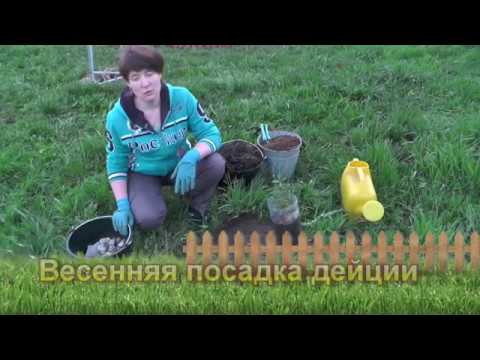

Watch this video on YouTube
Action care
There is nothing difficult in caring for such a shrub, while a layer of mulch will save you some of the work. Action reacts negatively to waterlogging, so you need to water it infrequently. It will be enough 1 watering per week, while 10 liters of water should go to 1 bush. During a hot dry season, the amount of water should be increased to 20 liters per bush. From the second half of August, the plant ceases to be watered altogether. When watering is finished, you need to loosen the soil to a depth of 20 to 25 centimeters, while removing all the weeds. Top dressing is carried out 1 time in 4 weeks, for this, 3-4 liters of liquid manure are poured under each bush. During the season, it is necessary to feed the action with complex mineral fertilizer (per bush from 120 to 150 grams) only 2 times. The plant is fed only during flowering.
Transfer
This shrub can be transplanted only in spring. The fact is that a specimen transplanted at other times of the year does not have time to take root before the onset of winter. The plant must be dug out carefully, while the clod of earth on the root system should not be destroyed. The bush must be dug along the perimeter of the projection of its crown, it is pulled out of the ground along with the roots and a lump of earth. Then it is moved to a new planting hole, which should be prepared in advance, while 20 to 30 grams of complex mineral fertilizer should be poured into it.To fill the hole, use the same substrate as during planting, while it must be properly compacted, and the plant must be watered. For a transplanted specimen, it is recommended to remove all old branches, and those that remain must be cut off by 1/3 part. In this case, the trunk circle must be sprinkled with a layer of mulch (peat). If the bush is young, then it will get sick quickly enough, but an adult bush will hurt for a relatively long time.
Cropping action
Caring for such a plant includes regular pruning. The action should be cut twice per season - in spring and autumn. In autumn, the branches blooming this year should be cut to the base or to the first strong bud. You should also remove old branches and those due to which the crown thickens. Together with sanitary pruning, crown shaping is also done. In springtime, you need to shorten those branches that are frozen, and also remove the injured ones. In the event that the bush has suffered very badly during the winter, and more than half of its branches are broken, then it is recommended to cut such a plant "on a stump". Anti-aging pruning is done in the same way.
Diseases and pests
The shrub has a fairly high resistance to diseases and harmful insects. Very rarely, he can be harmed by a bumblebee proboscis, which feeds on deytion leaves. It is necessary to process the bush with a solution of Karbofos or Phthalofos, which should be fifteen percent.
Deytion after flowering
During flowering, the action looks just amazing, it is especially pleasing that the flowers on the plant last for a very long time. However, the time comes, and it still ends, and here it is not far from winter. When planting a shrub, take into account that its resistance to cold is very low. Due to the fact that flowers appear only on last year's shoots, they need to be protected from frost as best as possible. Otherwise, the plant will not bloom next year. In areas where winters are mild and there is a lot of snow, it is not necessary to cover the shrub, but its branches still need to be bent to the surface of the ground.
Caring for the action in the suburbs
In the same places where the winters are frosty or with little snow, an obligatory shelter for wintering is required. Moreover, only the snow cover will not be able to protect this plant from frost. Experienced gardeners recommend using an air-dry shelter to prepare such a shrub for winter. To do this, the shrub must be bent to the surface of the ground and fixed. After that, you need to make a frame over it. The surface of the frame must be sprinkled with a layer of dry leaves or covered with spruce branches. From above, everything is covered with lutrasil, and a polyethylene film is stretched over it. This is necessary so that water cannot penetrate inside. This method of shelter is ideal for young shrubs, as their branches bend very easily to the ground surface. If the shrub is adult, then it should be tied tightly with twine or twine. Over the bound bushes, it is imperative to wrap it with a covering material that must allow air to pass through (burlap, spunbond or lutrasil). This will help protect the plant from cold weather, while the buds will not rot.
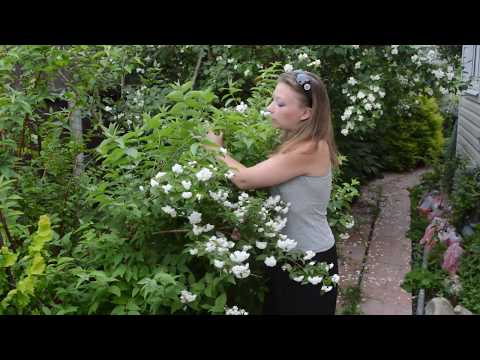

Watch this video on YouTube
Types and varieties of action with photos and names
Several species and varieties of action are cultivated in mid-latitudes, some of which are relatively popular.
Deutzia amur, or small-flowered (Deutzia amurensis)
This plant can be found in natural conditions in China, North Korea and the Far East. On the territory of Russia, this plant is protected in several reserves. It prefers to grow in coniferous-deciduous and oak forests, while it can be found at an altitude of about 1.4 thousand meters above sea level. Such a plant is a deciduous shrub with a spreading bush shape. In height, it can reach 200 centimeters.The branches are covered with brown bark, which eventually changes its color to gray. The length of oppositely located leaf plates is about 6 centimeters, they have an elliptical shape. They are wedge-shaped at the base, and sharpen towards the apex, finely serrate, with pubescence on both sides. In the spring and summer, they are rich green or green-ash color, and brown-yellow or ocher in the autumn months. Multi-flowered corymbose inflorescences reach 7 centimeters in diameter. They are composed of white, odorless flowers. The plant blooms for 20 days, while the beginning of flowering is in the last days of June. The fruits are rather inconspicuous and are painted in a dirty yellow color, they look like almost spherical bolls. This species is distinguished by moisture and light-requiring, as well as resistance to drought, gases and smoke. The plant is fast-growing, begins to bloom relatively early.
Deutzia graceful (Deutzia gracilis)
The native land of the plant is the mountains of Japan. The height of the bush can vary from 50 to 150 centimeters. The bush has a rounded shape, thin arcuate branches. It blooms very luxuriantly. The leaf plates are oblong-lanceolate, they are elongated and sharpened towards the apex, the edge is not serrate. They are about 6 centimeters long and are painted in a pale green color. The seamy surface of the leaflet is naked, and on the front side there are stellate hairs. The flowers are white, they are part of upright, multi-flowered racemose inflorescences, which reach about 9 centimeters in length. Flowering begins in the second half of July, while its duration is 35 days.
Deytion rough, or star-shaped (Deutzia scabra)
Originally from Japan and China. The height of the graceful bush is about 250 centimeters. The color of the peeling bark over time is brown or light red. The length of the pale green leaf plates is 3–8 centimeters. There are small stellate hairs on their surface, which give the leaf a roughness. In this species, flowering begins later than all others. The length of the brushes, consisting of white or pink flowers, is 12 centimeters. The action blooms from 15 to 20 days. Decorative forms:
- Terry... The inside of the double flowers is white, while the outside is pink.
- Pure white... Has double flowers of white color.
- Vaterera... The flowers are white inside, and the outside is carmine.
- Pink terry... There are double pink flowers. The form is highly resistant to frost.
- Belochechnaya... With small white dots on the leaf plates.
Deytsiya magnificent, or magnificent (Deutzia magnifica)
This hybrid plant was born thanks to the crossing of the Vilmorin action and the rough action. In height, the erect bush reaches about 250 centimeters. The leaf plates are elongated, ovoid. Terry white flowers are part of large paniculate umbellate inflorescences, which are about 10 centimeters long. The flowering is incredibly plentiful; under the weight of the inflorescences, the branches acquire an arched bend. The plant begins to bloom in July, with a flowering duration of about 20 days. This species is one of the most beautiful.
Deutzia longifolia (Deutzia longifolia)
The shrub height varies from 100 to 200 centimeters. There is pubescence on the surface of the shoots. The length of the leaves is about 12 centimeters, they are finely toothed along the edge. They are dark green on the front side, and greenish-gray from the pile on the back. The diameter of the lilac-pink flowers is about 25 mm, in the buds they are purple. Flowering begins in mid-July. There is a long-leaved variety of Veitch, its flowers have a darker color.
Deutzia x lemoinei
This hybrid appeared due to the crossing of the graceful action and the small-flowered action. The bush reaches a height of about 200 centimeters. It blooms early and luxuriantly. Snow-white flowers have a diameter of about 20 mm, while they are part of small inflorescences, the length of which is 10 centimeters.The flowering is beautiful, lush and long lasting, and the plant also has good frost resistance. Highly decorative varieties:
- Belle de nej... The height of the bush is about 150 centimeters. The white flowers are about 25 mm in diameter.
- Mont rose... The bush reaches a height of 250 centimeters. The flowers are large, deep pink. The edges of the petals are rolled up so that the yellow anthers are visible.
- Pink Pompom... A relatively new variety. The buds are carmine, and the flowers are deep pink double. They are part of lush hemispherical inflorescences.
In addition to the species described, there are purple, large-flowered, Wilson and Vilmorin deuts in the culture.


Watch this video on YouTube

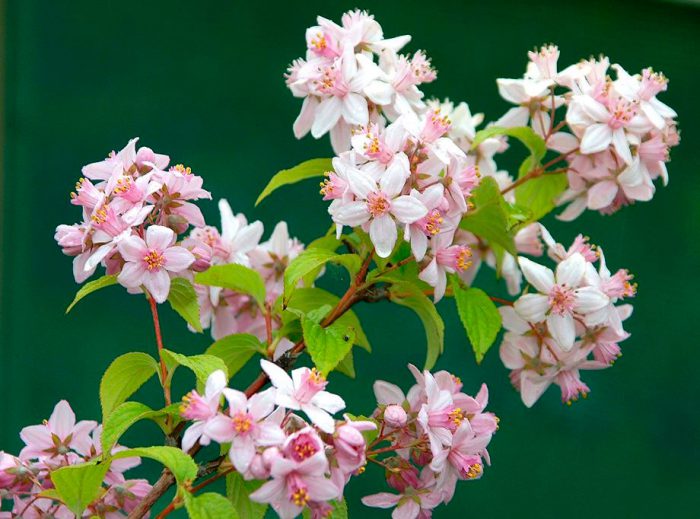
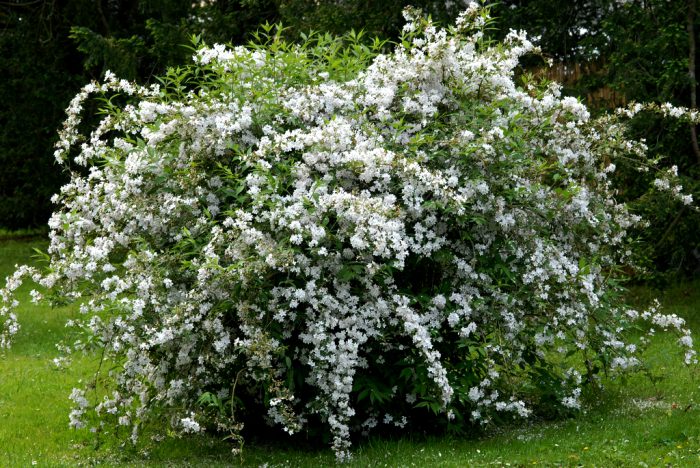
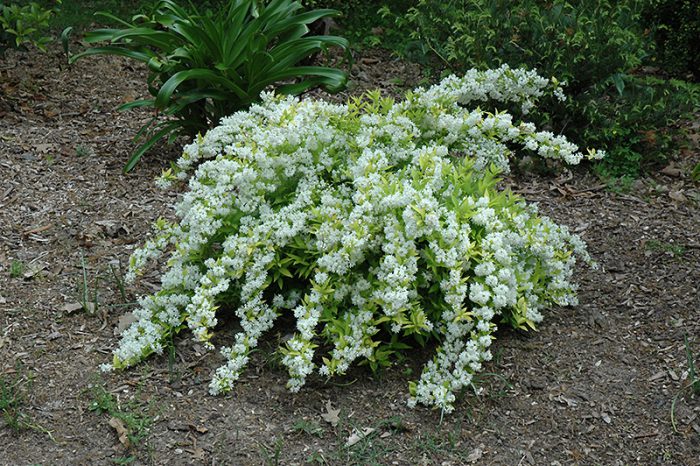

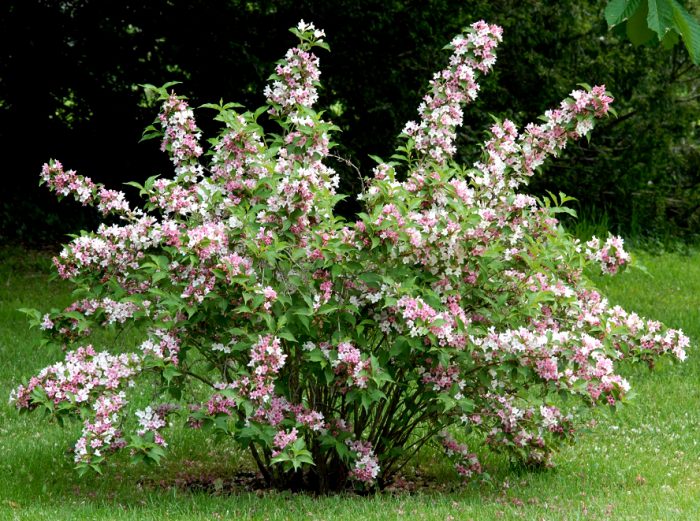
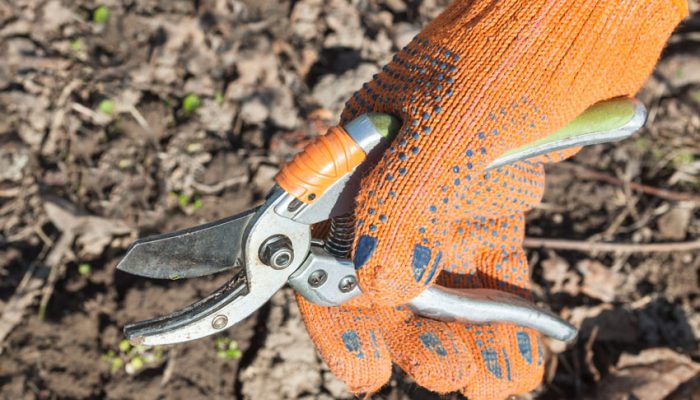

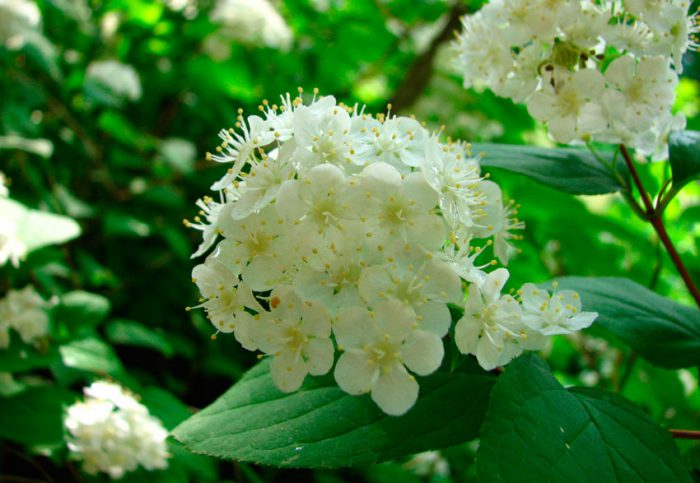
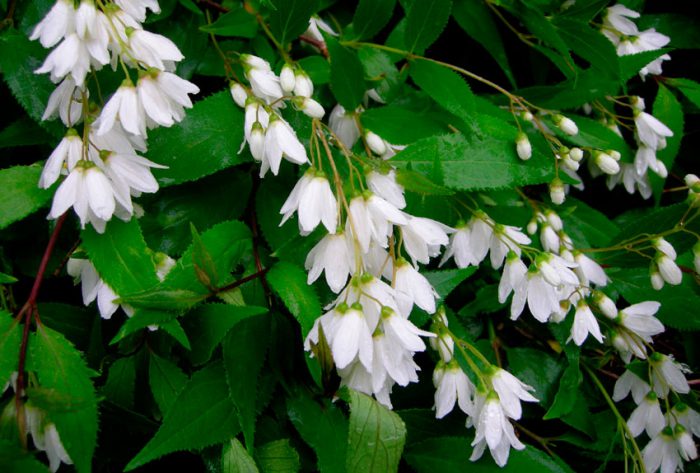


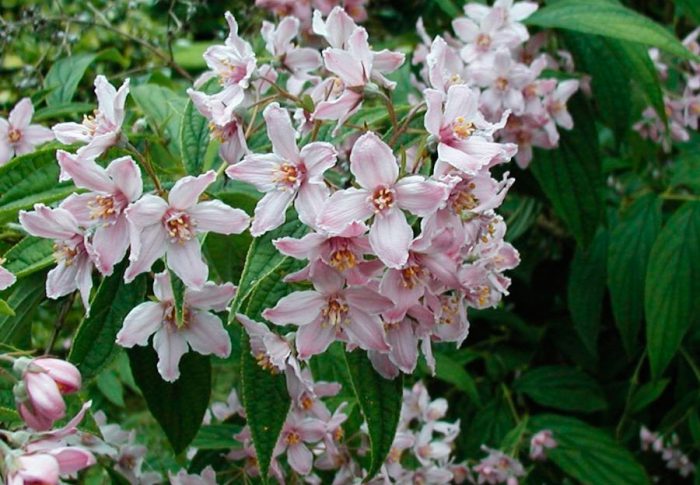
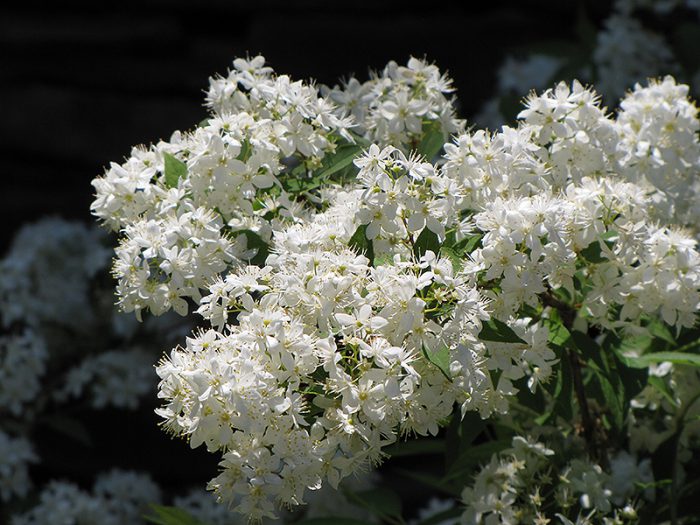
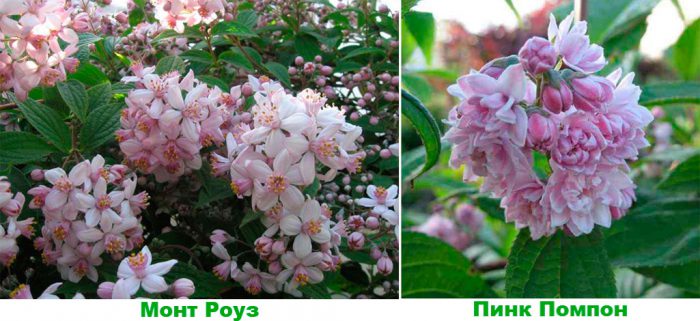










However, contradictory information .. first, the article states that pruning faded shoots and even on a stump, and then what blooms on the shoots of last year ... ?? Could you clarify??